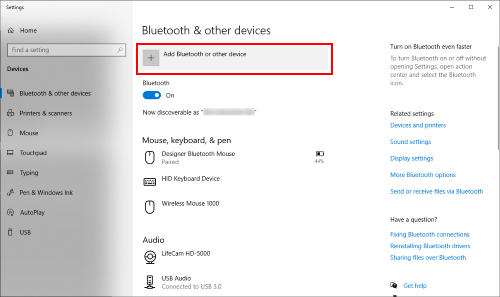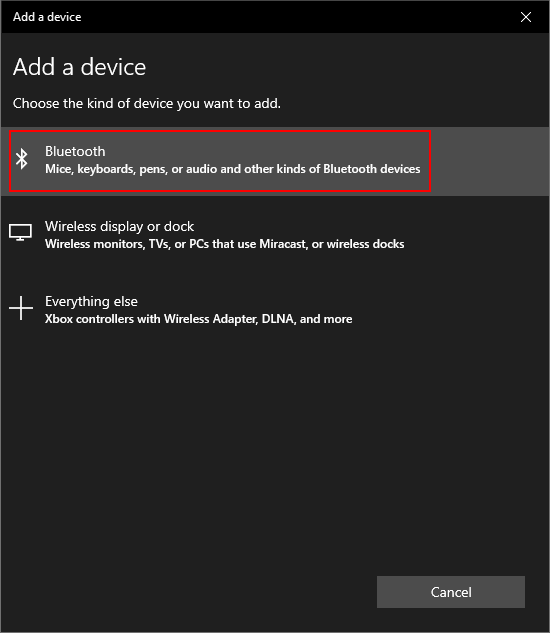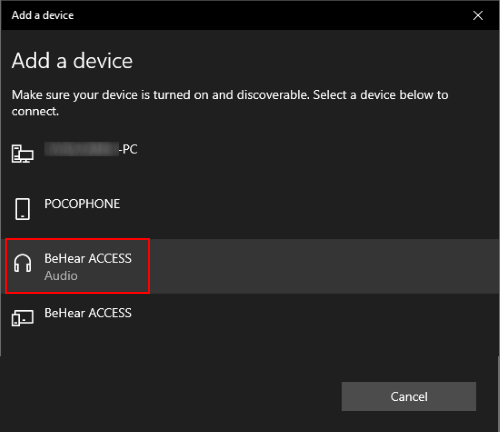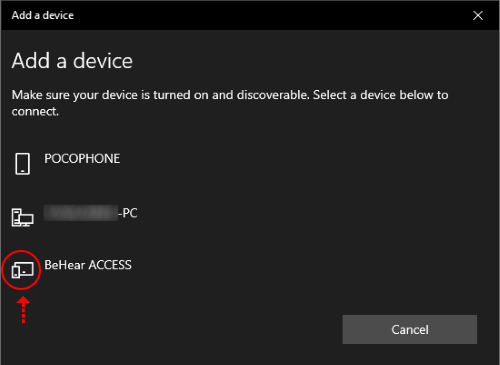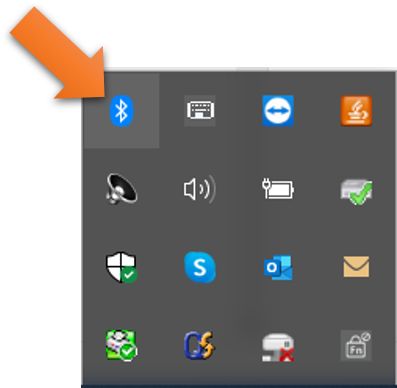After initially pairing PROXY successfully with HearLink PLUS, on subsequent use PROXY doesn’t connect automatically.
Once you have powered on the PROXY and are within Bluetooth range of the transmitting device the “auto-pairing” can take up to 20 seconds.
However, if a long time has passed between uses (or if you simply don’t want to wait), shift the BeHear PROXY neck speaker Power button briefly to initiate reconnection to the paired Bluetooth device (the HearLink PLUS transmitter, Bluetooth-enabled television, or the smartphone).
The connection should then be immediate.
How can I switch between TV watching and live conversations with SMARTO?
If you have paired SMARTO to a TV or other Bluetooth device simply press the red “hang-up call” button on SMARTO to pause the audio stream. After a few seconds the LED will shine yellow to indicate that you are in Personal Hearing mode. To switch back to the streamed audio press the green “answer call” button on SMARTO. The LED will shine in blue to indicate the Bluetooth is active.
Is it possible for others to hear the TV while I am using my BeHear headset?
This depends on how you are using your BeHear ACCESS, and your specific TV.
- If you are using BeHear in Personal Hearing mode to amplify nearby important sounds, others will be able to hear the TV as well.
- If you are using BeHear as a Bluetooth receiver, paired with your television, others will probably not be able to hear the TV. However, if your television (or set top box) supports simultaneous sound output to optic/RCA/3.5mm and the TV speakers, we have a recommendation for a workaround (see below).
If your television doesn’t support Bluetooth, or if it doesn’t support dual audio output when a Bluetooth device is connected, we recommend using a Bluetooth transmitter, such as our HearLink PLUS, to enable the television audio to be transmitted to both your BeHear headset and the TV speakers.
In any event, you should check your television manual for information about Bluetooth connections and dual audio output.
There is latency (delay) in my headset’s audio.
The degree of latency is determined by the transmitter. Paired Bluetooth devices can only communicate by using the same audio CODEC. If your transmitter* does not support the aptX-LL low-latency Bluetooth audio CODEC, even though your BeHear headset does, you may sense a delay in the audio delivery.
- aptX-LL provides the best performance with minimal latency. It is the recommended setting, and the BeHear default.
- aptX is similar to aptX-LL but the latency is slightly longer.
- SBC is the standard Bluetooth CODEC supported by all devices, latency is long and not fixed.
* The HearLink PLUS transmitter does support the aptX-LL low-latency audio CODEC, so you will not detect any audio delay when using it with your BeHear headset.
Bluetooth connection is not stable during phone calls.
In this case we recommend placing your mobile phone in front of you or in your hand, but not in a tight pocket or otherwise pressed against your body, as the body blocks the Bluetooth signal.
When pairing BeHear via Bluetooth with my computer the device shows both “headset” and “headphones” entries. Which should I choose?
Oftentimes, when you connect BeHear to your computer, you will see two BeHear entries: one as Headphone and one as Headset. For best results we recommend the following:
- For 2-way communication – Use the headset entry if you are on a video or audio call and the headset communication is two-way (send and receive).
- For 1-way communication (streaming only) – Use the headphone entry if you will be using BeHear for music/audio listening.
What is the typical range of Bluetooth in the BeHear NOW and ACCESS headsets?
Bluetooth range for Class II devices like our BeHear NOW and ACCESS headsets is up to ~33 feet (10 meters). This holds true even if you leave the room.
Note: There may be interference from other electronic devices or objects which will affect that range.
How do I pair the headset to my phone?
- Using your smartphone, download the free W&H BeHear app from Google Play Store or the Apple Store.
- Open the W&H BeHear app, and choose an interface language.
- You will be prompted to indicate which headset you have (either BeHear NOW or BeHear ACCESS).
- The app will then show you how to put the headset into pairing mode (your phone’s Bluetooth option must be active).
- Follow the app’s on-screen prompts to connect the headset to your phone.
- Once the connection is successful, the headset will be turned off automatically. You are instructed to press its power button to turn it back on.
- Once the headset is back on, the pairing process is complete and you should start the hearing assessment.
How do I pair the headset to my Windows Desktop PC?
- To connect your BeHear headset to a Windows PC desktop computer, first you must place the headset into pairing mode (when the headset is OFF, press the power button for several seconds until the LED flashes alternating red and blue lights).
- Then (and only then!) go to Settings > Bluetooth & other devices on your Windows PC.
- Click the “Add Bluetooth or other device” option
- Click “Bluetooth”:
- Your BeHear headset will appear as an audio device in the list next to a “headphone” icon. Click on this device name to connect:
Note: If you don’t follow the sequence detailed above, and instead start searching for new device in the PC while your headset is simply ON (not in pairing mode), BeHear will appear in the list as unknown device, with no “audio” under the name and no “headphone” icon next to it. Connecting to this device will not activate BeHear as a headphone/headset.
What range can I expect with the BeHear headset + HearLink PLUS combination?
The operational distance for the HearLink PLUS paired with a BeHear NOW or BeHear ACCESS is up to ~200ft (~60m).
If you are interested in a more detailed explanation, keep reading.
The BeHear NOW and BeHear ACCESS headsets are Bluetooth Class II devices, while the HearLink PLUS is a Bluetooth Class I device.
- A Bluetooth link between two devices is always bi-directional. The actual range depends on radio performance of the transmitter and the receiver on the both sides.
- The difference between Class I and Class II Bluetooth devices in radio transmitting power is 16dB (Class I – 20dBm, Class II – 4dBm). Consequently, the power transmitted by a Class I device is ~40 times greater than that of a Class II device (10^(16/10)). The distance is a function of the square root of the power, meaning that the distance can be increased by ~6 times (SQR(40)) from 10m for Class II to 60m for Class I.
- In addition, a Class I device has improved receiver sensitivity (by ~4dB), which leads to an increased distance of ~1.5 times. Consequently, typical distance for Class I is 100m vs. 10m for Class II.
- When a Class I device is connected to a Class II headset the expected distance is as follows:
a. From a Class I transmitter to a Class II receiver – up to 60m (see paragraph #2)
b. From a Class II transmitter to Class I receiver – up to 15m (see paragraph #3)
c. For a bi-directional it is ~15m, based on the shortest range of #a and #b. - HearLink PLUS as a Class I device provides additional improvements because of its dual-antenna design. The major effect is for the receiving part, since transmitting power is limited according to the standard. For communication with a Class II receiver, like our BeHear headsets, the distance is increased significantly because of this improvement.
My BeHear headset is not pairing with my laptop computer.
Make sure that the Bluetooth option on your computer is set to “on”. This option is usually found in the “Settings” section, “Bluetooth and Other Devices” sub-section.
On Windows computers you can quickly access the Bluetooth settings from the action center in the system tray.
If you don’t see the Bluetooth icon here it may be an indication that Bluetooth is not active. In this case, go to the computer Settings → Devices and make sure the Bluetooth switch is ON. If it is not, slide it to the right to activate Bluetooth.
What can I do when my HearLink transmitter loses connection with my BeHear headset?
First, verify that you are within Bluetooth range (~10 feet, 3.5 meters for HearLink; ~200 feet, 60 meters for HearLink PLUS).
If that is not the issue, and a long time has passed between uses, or if the smartphone has been playing an audio stream, the headset may not automatically reconnect with the HearLink or HearLink PLUS transmitter when you are within range. In this case, a short press on the headset’s Power button should re-establish the connection with the transmitter.
Which Bluetooth headsets support the aptX codec?
The current versions of both our headsets (BeHear NOW and BeHear ACCESS) support both the Qualcomm aptX “classic” and aptX-LL (low latency) codecs.
Can I use my BeHear headset to hear audio from my laptop computer?
Yes, absolutely!
Depending on the application, BeHear may appear either as a headset or as a headphone, just like most other Bluetooth headphones.
For most music players it will be listed as a “headphone” while for messaging services, such as Skype/Viber/WeChat etc., it will be listed as a “headset”.
Connecting the HearLink TV transmitter blocks the television audio for the rest of the viewers.
If you have a set top box you may be able to use it to bypass the television’s audio output jack and solve this problem. Many set top boxes (cable boxes) have an analog audio output jack and/or an optical (digital) audio output jack. By connecting the HearLink PLUS TV transmitter directly to the set top box the audio may transmit simultaneously to the BeHear headset and the television speakers, allowing both the BeHear wearer and the other viewers to hear the audio.
I cannot find an audio output jack for the HearLink on my television.
If you have a set top box you can use it instead, as many set top boxes (cable boxes) have an analog audio output jack and/or an optical (digital) audio output jack. In this case, connect the HearLink/HearLink PLUS TV transmitter directly to the audio output jack on the set top box.
